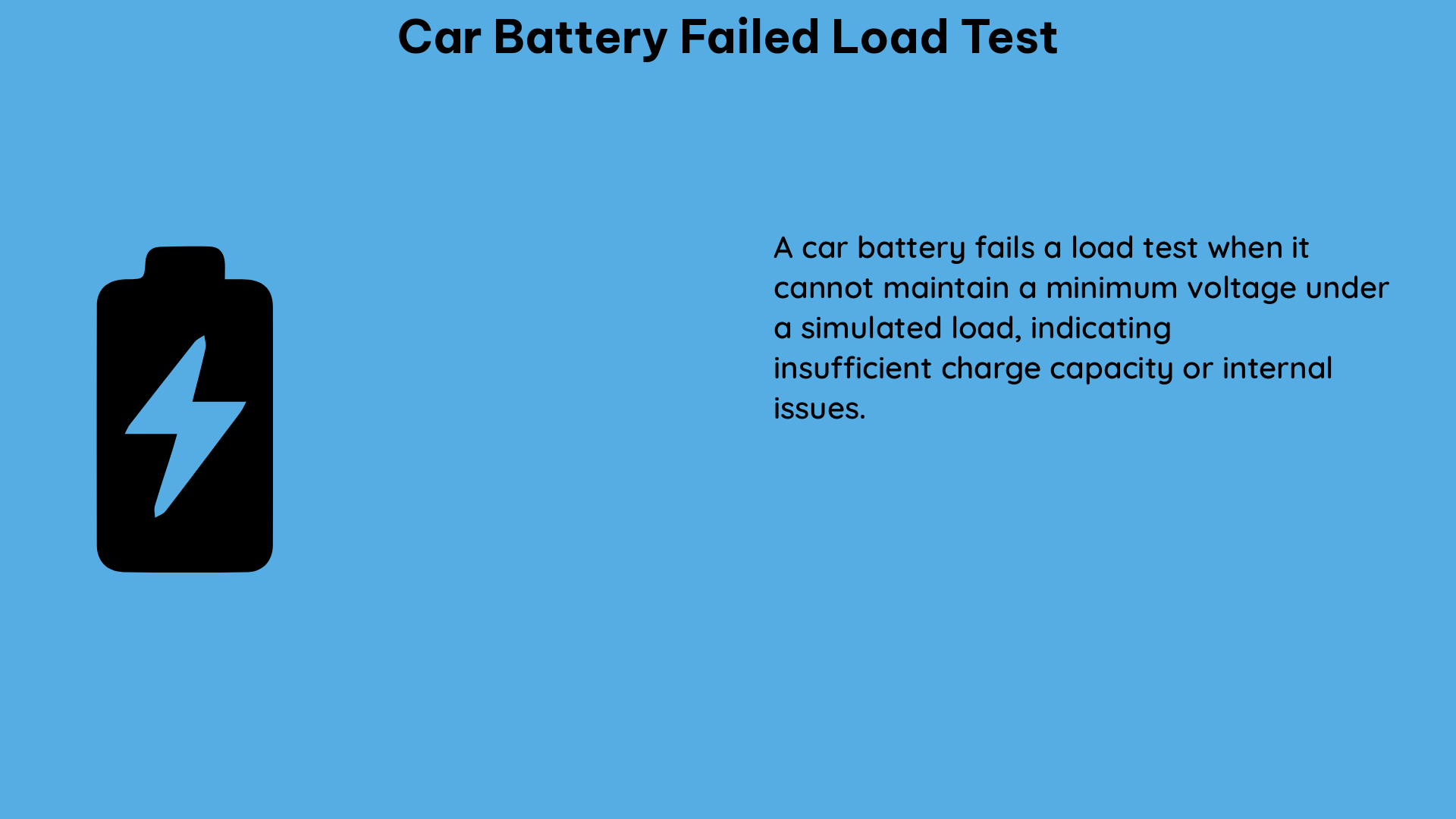A car battery failed load test is a clear indication that the battery is unable to maintain a sufficient voltage under a load, which can be a sign of a weak or failing battery. This test is typically performed by applying a load to the battery and measuring its voltage over a period of time. If the voltage drops below a certain threshold, the battery is considered to have failed the load test.
Understanding the Technical Specifications of a Load Test
The technical specifications of a load test for a car battery can vary depending on the type of test being performed. There are two main types of load tests: conductance and carbon pile.
Conductance Test
A conductance test measures the ability of the battery to conduct electrical current and is a non-destructive test, meaning it does not put a load on the battery. The results of a conductance test are given in terms of a conductance value, which is a measure of the battery’s ability to conduct electrical current. A low conductance value indicates a weak or failing battery.
The conductance value is typically measured in millisiemens (mS) or microsiemens (μS). A healthy battery should have a conductance value of at least 300 mS, while a battery with a conductance value below 200 mS is considered to be weak or failing.
Carbon Pile Test
A carbon pile test, on the other hand, applies a load to the battery and measures its voltage over a period of time. The results of a carbon pile test are given in terms of the battery’s voltage under load. A low voltage under load indicates a weak or failing battery.
During a carbon pile test, a load is applied to the battery, typically around 50-75% of the battery’s cold cranking amps (CCA) rating. The voltage of the battery is then measured over a period of time, usually 15 seconds. A healthy battery should maintain a voltage of at least 9.6 volts under this load, while a battery with a voltage below 9.0 volts is considered to be weak or failing.
Interpreting the Results of a Load Test

The specific results of a load test for a car battery can vary depending on the make and model of the battery, as well as the temperature and age of the battery.
Specific Gravity
A new battery should have a specific gravity of around 1.265-1.295, which is a measure of the battery’s electrolyte density. If the specific gravity is outside of this range, it may indicate a problem with the battery.
Battery Voltage
A fully charged battery should have a voltage of around 12.6-12.8 volts. If the voltage is outside of this range, it may indicate a problem with the battery.
Cold Cranking Amps (CCA)
The load test results should be compared to the battery’s CCA rating, which is a measure of the battery’s ability to start an engine in cold temperatures. If the battery’s CCA rating is significantly lower than the load test results, it may indicate a problem with the battery.
Diagnosing and Fixing a Failed Load Test
In order to diagnose and fix a car battery that has failed a load test, it is important to first determine the cause of the failure. This may involve checking the battery’s connections, cleaning any corrosion, and ensuring that the battery is fully charged.
Checking Battery Connections
Ensure that the battery’s terminals are clean and tight, and that the cable connections are secure. Corrosion on the terminals or loose connections can cause a drop in voltage during a load test.
Cleaning Battery Corrosion
If there is visible corrosion on the battery terminals or cable connections, it should be cleaned using a wire brush or baking soda and water solution. Corrosion can prevent the battery from maintaining a sufficient voltage under load.
Charging the Battery
Ensure that the battery is fully charged before performing a load test. A partially charged battery may not be able to maintain a sufficient voltage under load.
If the battery is still not able to pass a load test after these steps, it may need to be replaced. A battery that fails a load test is typically considered to be weak or failing and should be replaced to ensure reliable starting and electrical system performance.
Conclusion
A car battery failed load test is a clear indication that the battery is unable to maintain a sufficient voltage under a load, which can be a sign of a weak or failing battery. Understanding the technical specifications of a load test, including conductance and carbon pile tests, as well as interpreting the results in terms of specific gravity, battery voltage, and CCA rating, is crucial for diagnosing and fixing a failed load test.
By following the steps outlined in this guide, including checking the battery connections, cleaning corrosion, and ensuring the battery is fully charged, you can effectively diagnose and fix a car battery that has failed a load test, ensuring reliable starting and electrical system performance.
References:
– Community Car Talk: Battery Failed Load Test
– Tacoma World: Battery Failed Load Test
– Purkeys: Load Testing Vehicle Batteries in Three Steps
– Yesterday’s Tractors: Full Charge Fails Load Test
– Reddit r/Cartalk: Battery Load Test Failed but Car is Just Only 2

The lambdageeks.com Core SME Team is a group of experienced subject matter experts from diverse scientific and technical fields including Physics, Chemistry, Technology,Electronics & Electrical Engineering, Automotive, Mechanical Engineering. Our team collaborates to create high-quality, well-researched articles on a wide range of science and technology topics for the lambdageeks.com website.
All Our Senior SME are having more than 7 Years of experience in the respective fields . They are either Working Industry Professionals or assocaited With different Universities. Refer Our Authors Page to get to know About our Core SMEs.